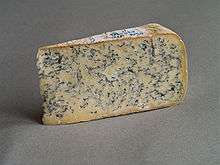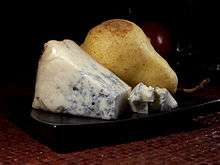Blue cheese


Blue cheese is a general classification of cheeses that have had cultures of the mold Penicillium added so that the final product is spotted or veined throughout with blue, or blue-grey mold and carries a distinct smell, either from that or various specially cultivated bacteria. Some blue cheeses are injected with spores before the curds form, and others have spores mixed in with the curds after they form. Blue cheeses are typically aged in a temperature-controlled environment such as a cave. Blue cheese can be eaten by itself or can be spread, crumbled or melted into or over foods.
The characteristic flavor of blue cheeses tends to be sharp and salty. The smell of this food is due both to the mold and to types of bacteria encouraged to grow on the cheese: for example, the bacterium Brevibacterium linens is responsible for the smell of many blue cheeses,[1] as well as foot odor and other human body odors.[2]
History
Blue cheese is believed to have been discovered by accident when cheeses were stored in natural temperatures and moisture-controlled caves, which happened to be favorable environments for many varieties of harmless mold. According to legend, Roquefort was discovered when a youth, eating a lunch of bread and ewes' milk cheese, abandoned his meal in a nearby cave after seeing a beautiful girl in the distance. When he returned months later, the mold (Penicillium roqueforti) had transformed his cheese into Roquefort.[3][4]
It is often claimed Roquefort was praised by Pliny the Elder in AD 79. However, in the text, Pliny speaks of a cheese from Gaul, without mention of origin or even specifying that it was blue.[5] This story was promoted by the 'Société des Caves.[6]
Gorgonzola is one of the oldest known blue cheeses, having been created around 879 AD, though it is said that it did not actually contain blue veins until around the 11th century.[7][8] Stilton is a relatively new addition becoming popular sometime in the early 1700s.[9] Many varieties of blue cheese that originated subsequently, such as the 20th century Danablu and Cambozola, were an attempt to fill the demand for Roquefort-style cheeses that were prohibitive due to either cost or politics.
Nutritional information
100 g of generic blue cheese contains the following nutritional values according to the USDA:[10]
- Calories: 353
- Fat: 28.74 grams
- Carbohydrates: 2.34 grams
- Fiber: 0 grams
- Protein: 21.40 grams
- Vitamin B12: 1.15 mg (50% of recommended daily intake)
Production
Creation
Similarly to other varieties of cheese, the process of making blue cheese consists of six standard steps, as well as further additions that give this blue-veined cheese its unique properties. The first step is acidification where a starter culture is added to milk in order to change lactose to lactic acid, thus changing the acidity of the milk and turning it from liquid to solid. The next step is coagulation, where rennet, a mixture of rennin and other material found in the stomach lining of a calf is added to solidify the milk further. Following this, thick curds are cut typically with a knife to encourage the release of liquid or whey. The smaller the curds are cut, the thicker and harder the resulting cheese will become. Salt is then added to provide flavor as well as to act as a preservative so the cheese does not spoil. Next, the cheese is given its form and further pressed with weights if necessary to expel any excess liquid. The final step is ripening the cheese by aging it. The temperature and the level of humidity in the room where the cheese is aging is monitored to ensure the cheese does not spoil or lose its optimal flavor and texture.[11]
Blue cheese undergoes the aforementioned steps with an added twist that gives it its unique look of blue streaks found all throughout. The blue veins are a result of adding the molds Penicillium roqueforti and Penicillium glaucum to the cheesemaking process, often introduced after the curds have been ladled into containers in order to be drained and formed into a full wheel of cheese. Although Penicillium roqueforti and Penicillium glaucum are found naturally, cheese producers nowadays use commercially manufactured Penicillium roqueforti culture that have been freeze-dried, a form of dehydration where water is evaporated from the frozen state without the transition through the liquid state, to retain their value and are activated with the addition of water. After the addition of the molds to the cheese, the next significant step is needling, which is when the wheels of blue cheese are pierced to create small openings to allow the air to enter and feed the mold cultures, thus encouraging the formation of blue veins.[12]
European Union
In the European Union, many blue cheeses such as Roquefort, Danablu, Cabrales, Gorgonzola and Blue Stilton carry a protected designation of origin, meaning they can bear the name only if they have been made in a particular region in a certain country. Similarly, individual countries have protections of their own such as France's Appellation d'Origine Contrôlée and Italy's Denominazione di Origine Protetta. Blue cheeses with no protected origin name are designated simply "blue cheese".
See also
References
- ↑ Deetae P; Bonnarme P; Spinnler HE; Helinck S (October 2007). "Production of volatile aroma compounds by bacterial strains isolated from different surface-ripened French cheeses". Appl. Microbiol. Biotechnol. 76 (5): 1161–71. doi:10.1007/s00253-007-1095-5. PMID 17701035.
- ↑ thebmj
- ↑ Fabricant, Florence (June 23, 1982). "Blue-veined Cheeses : The expanding choices". New York Times. Retrieved May 22, 2010.
- ↑ "Something is rotten in Roquefort". Business Week. December 31, 2001.
- ↑ Howard Belton, A History of the World in Five Menus, n.p.
- ↑ Nelleke Teughels, Peter Scholliers, A Taste of Progress: Food at International and World Exhibitions in the Nineteenth and Twentieth Centuries, ISBN 1317186435, p. 186
- ↑ "Gorgonzola, the cheese that lives". Italian Food Excellence. Retrieved 7 August 2016.
- ↑ "Castello® Gorgonzola". Castello. Retrieved 7 August 2016.
- ↑ "History of Stilton". StiltonCheese.co.uk. Retrieved 7 August 2016.
- ↑ National Nutrient Database for Standard Reference Release 27 - Basic Report: 01004, Cheese, blue
- ↑ Blue Cheese Production
- ↑ Blue Cheese Production
External links
| Wikimedia Commons has media related to Blue cheese. |
